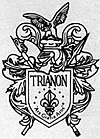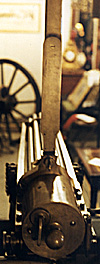 The Trianon Museum and Art Gallery is a small antique shop, located in downtown Denver, packing an inventory of interesting objects worthy of a museum, including furniture and household items from the Russian Imperial palaces, 18th century French palaces and chateaus, and Chinese and Japanese screens.
The Trianon Museum and Art Gallery is a small antique shop, located in downtown Denver, packing an inventory of interesting objects worthy of a museum, including furniture and household items from the Russian Imperial palaces, 18th century French palaces and chateaus, and Chinese and Japanese screens.
 Of military interest is an Antique Gun Collection displaying a couple dozen examples of firearms from the 16th to the 20th centuries, with the centerpiece being a Gatling Gun (Model 1877), serial number 1.
Of military interest is an Antique Gun Collection displaying a couple dozen examples of firearms from the 16th to the 20th centuries, with the centerpiece being a Gatling Gun (Model 1877), serial number 1.
Access is quite cramped, and lighting is difficult, but the Gallery is well worth a quick visit, and I believe you will be quite tempted to look at the rest of the shop's wares.
The Gallery offers a one-sided 4"x9" handout providing an overview of the 400 years of firearms technology and explaining the difference between the various types of guns. The information below is taken from that handout.
Matchlock
Large Photos of Various Firearms (slow: 142K)
Wheel-Lock
The wheel-lock type of ignition is believed to have been developed around 1510-1520AD, although the earliest example actually dated from 1530.
In a pan at the side of the gun barrel appears the upper edge of a serrated steel wheel. When the trigger is pulled, this wheel commences a rapid rotation, pressing against a piece of iron pyrite. The friction causes sparks among the powder grains in the pan, leading to ignition.
Snaphaunce
Between 1560 and 1580, this type first appeared. The flash pans became part of the lock rather than the barrel.
The flint struck the frizzen, causing sparks, which ignited the powder in the pan, which in turn ignited the main charge in the barrel. The frizzen and pan cover are separate.
Miquelet
Between 1580 and 1610, the Miquelet appeared, offering nothing new for ignition, but its frizzen and pan cover are are integrated.
Flintlock
Between 1610 and 1630, Marin le Bourgeoys and others developed the flintlock, which combined features of the Snaphousen and Miquelet. The battery, or frizzen, were in one piece so that the flict striking the steel opens the pan. A halfcock safety position was also installed.
After 1700, it became the leading weapon. Made originally in the US in Pennsylvania by German and Swiss immigrants, it became so popular in Kentucky and Tennessee that the name "Kentucky flintlock" is the most commonly known name of the firearm.
Percussion
A Scottish minister, Alexander Forsyth, invented the use of potassium chlorate in the ignition process. When placed in a tube leading to the bore and struck by a hammer, the potassium chlorate flashed and ignioted the main charge. This led to percussion caps.
Pinfire or Dreyse Rifle
The needle gun developed by von Dreyse in 1827 used a long pin to strike the fulminate of mercury primer at the base of the bullet. This system was the start of the bolt action firearm and until 1871, this pinfire type of system was standard in the Prussian Army until the Mauser appeared.
Cartridge
At right, a .30 cal Springfield 1896 rifle used in the Spanish American War.
Gatling
Large Photos of Gatling Gun (very slow: 260K)
12 lb. Mountain Howitzer
Large Photos of Mountain Howitzer (82K)
Trianon Museum and Art Gallery The Trianon is two blocks from Civic Center Park at the corner of 14th and Tremont.
Colorado History Museum (Denver, CO)
This article appears in MagWeb (Magazine Web) on the Internet World Wide Web. A specially prepared cord or "match" was lowered into a pan containing a bit of powder. The resulting flash entered the touchhole leading to the bore of the barrel to detonate the charge.
A specially prepared cord or "match" was lowered into a pan containing a bit of powder. The resulting flash entered the touchhole leading to the bore of the barrel to detonate the charge.
 Between 1650 and 1867, many experiments led to the center fire and rim fire. In 1884, nitro cellulose was developed in France and in 1886 smokeless poweder appeared, to be almost universally used by 1900.
Between 1650 and 1867, many experiments led to the center fire and rim fire. In 1884, nitro cellulose was developed in France and in 1886 smokeless poweder appeared, to be almost universally used by 1900.
 Overshadowing all guns in the background is the original Model 1877 Gatling (at left), mounted on a field carraige with ammo boxes. Comprising 10 32-inch barrels, caliber .45-70, this gun fires up to 600 rounds a minute using a Bruce feed.
Overshadowing all guns in the background is the original Model 1877 Gatling (at left), mounted on a field carraige with ammo boxes. Comprising 10 32-inch barrels, caliber .45-70, this gun fires up to 600 rounds a minute using a Bruce feed.
 Mounted on a field carraige, this gun will fire a 9-pound ball 3,000 yards. This type played an important role in the American Civil War at the Battle of Glorieta Pass, March 27, 1862. The Union successfully repulsed the Confederates under Gen. Sibley, who attempted to march into Colorado via Apache Canyon (near Santa Fe, NM) and sieze the gold camps.
Mounted on a field carraige, this gun will fire a 9-pound ball 3,000 yards. This type played an important role in the American Civil War at the Battle of Glorieta Pass, March 27, 1862. The Union successfully repulsed the Confederates under Gen. Sibley, who attempted to march into Colorado via Apache Canyon (near Santa Fe, NM) and sieze the gold camps.
Contact
335 14th St.
Denver, Colorado 80203
303-623-0739
Open Mon-Sat, 10am-4pm
Back to List of Historic Sites
Back to Travel Master List
Back to MagWeb Master List of Magazines
© Copyright 1998 by Coalition Web, Inc.
Other military history articles and gaming articles are available at http://www.magweb.com